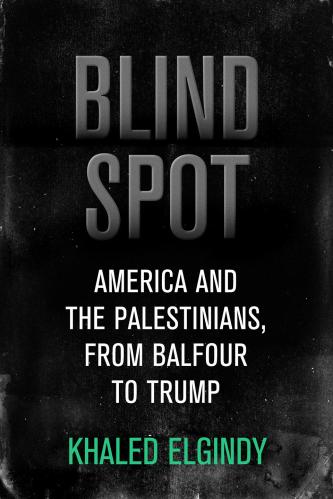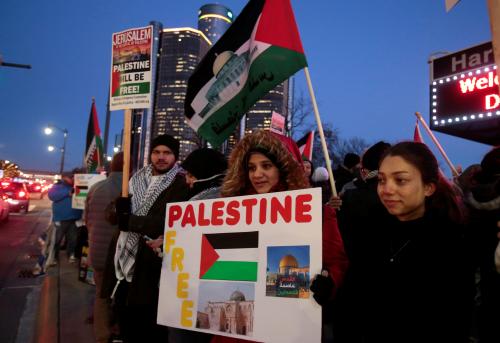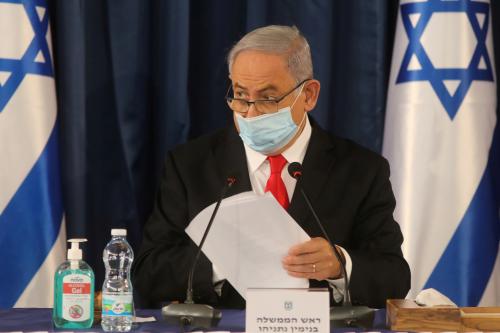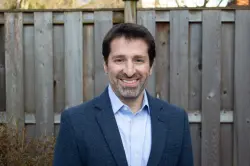The following is an excerpt from Reopening the World: How to Save Lives and Livelihoods, a new report where Brookings experts offer ideas to help policymakers protect lives and save livelihoods in the midst of the current COVID-19 pandemic.
 Israel reopened its economy in May to a general sense of success. The interim “bottom” line of the COVID-19 crisis was under 300 deaths nationally of a population of close to 9 million—a relatively contained provisional outcome in comparison to other countries. Israel had responded early and with stringent measures to the global pandemic. It had, moreover, successfully cooperated on health issues with both the Palestinian Authority in Ramallah and, separately, indirectly, and quietly, with the Hamas authorities in Gaza, where the risks of a full-blown outbreak are immense. The apparent success was uneven, however. One sector of society suffered the brunt of the pandemic, such as the Haredi (“UltraOrthodox”) community.
Israel reopened its economy in May to a general sense of success. The interim “bottom” line of the COVID-19 crisis was under 300 deaths nationally of a population of close to 9 million—a relatively contained provisional outcome in comparison to other countries. Israel had responded early and with stringent measures to the global pandemic. It had, moreover, successfully cooperated on health issues with both the Palestinian Authority in Ramallah and, separately, indirectly, and quietly, with the Hamas authorities in Gaza, where the risks of a full-blown outbreak are immense. The apparent success was uneven, however. One sector of society suffered the brunt of the pandemic, such as the Haredi (“UltraOrthodox”) community.
But the apparent early success spurred a debate among some scientists as well as the public about the appropriate response to the crisis, given the economic toll of the effort. Some have argued that the country’s low mortality rate was due more to its relatively young population than to the near shutdown of the economy. There is, in fact, a risk that the perception of early success may itself be a cause for subsequent complacency. Israelis and Palestinians emerged from the closure only to see early signs of upticks in infections, and a crisis contained in the spring may yet become a greater one by the fall.
EARLY MEASURES
Israeli authorities confirmed their first case of COVID-19 on February 21. By the first week of March, an outbreak was identified in the West Bank town of Beit Jalla, between Jerusalem and Bethlehem, and the latter city was closed to outside travel. The Israeli government banned all air travel from highly infected countries, a list that grew quickly to include European as well as East Asian countries. It ordered self-quarantine on those returning from all foreign destinations. By mid-March the government ordered the closing of kindergartens, schools, universities, and restaurants, and declared a general ban on congregations of more than 10 people. By April, the country was largely shut down, with strict limits placed on most people exiting their homes.
As the pandemic arrived in Israel the country was in the midst of a year of political crisis. The first confirmed case was identified less than two weeks ahead of a national election on March 2, the third such election in less than 12 months. A country well-versed in security crises—indeed a country technically still in a legal state of emergency since the first week of its existence—it was far less versed in handling a health crisis.
The ministry of health, which took the lead, was later joined in a command center east of Tel Aviv by other ministries as well as the military, police, the Mossad (the external security service, which precured equipment abroad from unnamed sources, likely among Arab Gulf states), and the Shin Bet (the internal security service, ISA or Shabak). The latter, with broad technical capacity in surveillance, usually of Palestinians, was deployed to the surveille Israeli citizens, tracking via cellphone data the movement of anyone infected. The measures were extreme, but in a medium-sized country accustomed to emergencies, they were met with relatively little complaint, aside from a warranted concern for a lack of parliamentary oversight over these measures during the political crisis.
With all that Israel was doing, it conspicuously hesitated to take a step its experts recommended: a travel ban on flights from the United States, where the crisis had already emerged, including among Orthodox Jewish communities in the greater New York area who have closed ties to sister communities in Israel. It emerged before long that Prime Minister Benjamin Netanyahu had overruled his experts for fear of angering President Trump. Indeed, when the travel ban was eventually put in place, it was instated as a then-still unnecessary global travel ban, in order not to single out Trump’s United States. One study in Israel suggested the link to the United States was the source of perhaps 70 percent of early cases in Israel.
COOPERATION BETWEEN THE PALESTINIANS AND ISRAEL
Despite the fraught relations between Israel and the Palestinian Authority in Ramallah, and the intermittent warfare between Israel and Hamas in Gaza, the sides managed to cooperate effectively during the crisis. Medics from Gaza—a territory under varying degrees of closure for 13 years— were brought in to Israel for training. A host of other quiet measures were taken to support the efforts, including the transfer of supplies and the relaxing of restrictions on exports, fueled by a fear of a catastrophic outbreak in Gaza, a crowded, enclosed area of about 140 square miles with nearly 2 million inhabitants. In the West Bank, where Israeli-Palestinian technical cooperation is far more routine, the efforts were likewise pragmatic.
Despite the fraught relations between Israel and the Palestinian Authority in Ramallah, and the intermittent warfare between Israel and Hamas in Gaza, the sides managed to cooperate effectively during the crisis.
If Israel benefits in this crisis from a young population, with about 42.5 percent under the age of 25, that is even more the case with the Palestinians. In the West Bank, more than half (56 percent) are under 25, and in the Gaza Strip, the figure is a staggering 64 percent. The three economies are also integrally linked. By far the largest destination for Palestinian exports is Israel, and the latter controls nearly all border crossings (with the exception of the Gaza-Egypt border). As a result, the three territories are linked in health crisis even more than in normal times. The same will be true as the crisis unfolds further.
THE TRIBES OF ISRAEL
The most senior Israeli official infected in the pandemic was the minister of health himself, Yaakov Litzman. It was lost on no one that he came from the Haredi community, the worst hit by the pandemic for reasons both demographic and societal. Along with hospitals, synagogues and religious boarding schools were the primary hotbeds of the pandemic in Israel. The Haredi community is one of the poorest in Israel. It has the largest average family size of any major population sector, and very strong habits of communal prayer and study (Orthodox Jewish prayer generally requires the presence of 10 Jewish men). A highly conservative community, it also looks to authority figures other than the government or the health and science community for guidance. One of the most important rabbis in the Haredi community, Rabbi Chaim Kanievsky, continued to issue instructions to continue communal religious study long after the government had ordered otherwise. Considered to be the preeminent Litvak rabbi, his instructions carry weight among many Haredim. By April 2, the government ordered a specific closure on Bnei Brak, a largely-Haredi city east of Tel Aviv.
The spread of the virus among Haredim, and their longstanding communal isolation among Israelis, contributed to their stigmatization during the crisis, but also to newfound solidarity between Israelis of different stripes. Forces deployed to help in Bnei Brak during the closure were supplied with Hebrew-Yiddish translation cheat sheets, to help soldiers dealing with a community where some converse in the Ashkenazi Jewish-German language. Tel Aviv, the real and symbolic center of secular Israel, projected on its town hall the words “Bnei Brak” in a sign of solidarity with its Haredi suburb.
Indeed, the pandemic also created some real soul searching within the Haredi community. Arieh Der’i, political leader of the largest Haredi party, Shas, spoke of the need for internal accountability. With the authority of an insider who is also a cabinet minister privy to the official data. A majority of the cases in Israel were among Haredim, he claimed, calling for soul searching within the community itself.
Larger than the Haredi community, another relatively poor sector in Israel came through the crisis with high marks: Arab (or Palestinian) citizens of Israel. Despite early fear that a lack of infrastructure and resources, and a history of suspicion between security forces and the large minority group (about 21 percent of the Israeli citizenry), the toll in the community inside Israel was contained. This owed, likely, to a combination of pragmatic cooperation of the authorities and the community, and to widescale civil society mobilization in a common effort.
THE DANGERS OF APPARENT SUCCESS
On April 20, the rate of recovery in Israel first outpaced the mortality rate, and the government announced the first measures to reopen the economy. These grew to include the opening of stores, malls, schools, and kindergartens. By late May, the country was mostly reopened, if still under orders toward precautions such as face masks and avoidance of major crowds. Some institutions, including some universities, may not open yet, despite the leeway to do so, and early signs emerging from the reopening suggest caution is warranted. By the end of May, an uptick in infections was recorded, including one in a Jerusalem high school. In the Gaza Strip, the first death was reported, as the total number of cases reached 55, and the Palestinian authorities in Gaza again shut the crossings to Israel. Israel has already announced that specific “signposts” would entail a return to national shutdown, including 100 new cases in one day, a 10-day doubling of cases, or 250 severe cases, nationally.
Of greatest concern, however, is the preparation for the possible next wave. Some Israelis may have learned the wrong lesson from the apparent success: that the crisis was simply overblown. The Israeli shutdown of the economy, like that in other countries, bought the state time to prepare—with widespread testing, random sampling of the population, and targeted rather than nationwide procedures. Israel’s battle with the first wave of the coronavirus pandemic appeared successful, if extremely damaging to the economy. The whole costly effort could turn out to be a waste if the country’s approach to a second wave was merely a replica of the first.








Commentary
Reopening the World: Israel reopens, but the risks persist
June 16, 2020